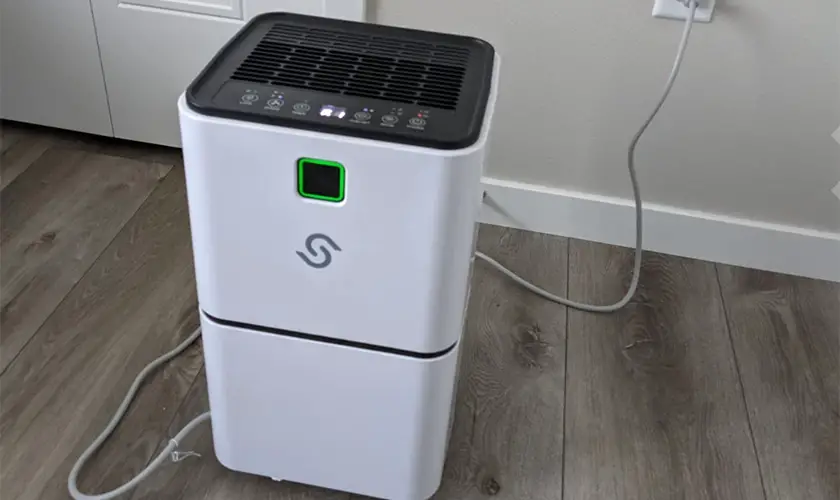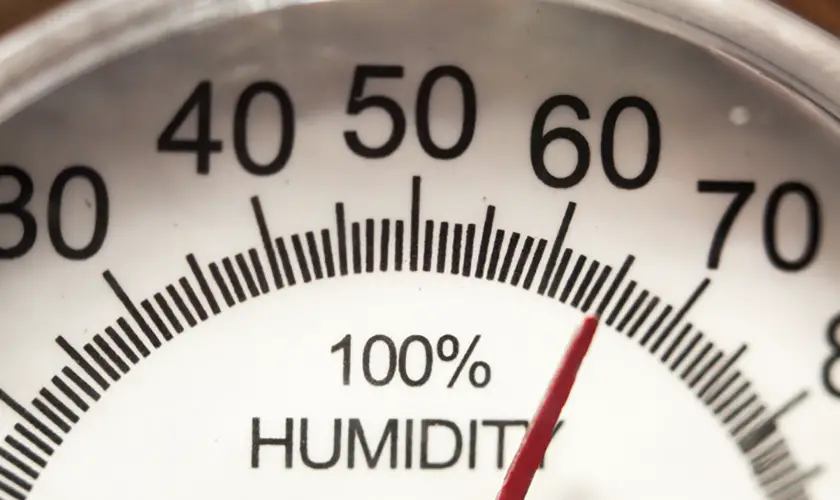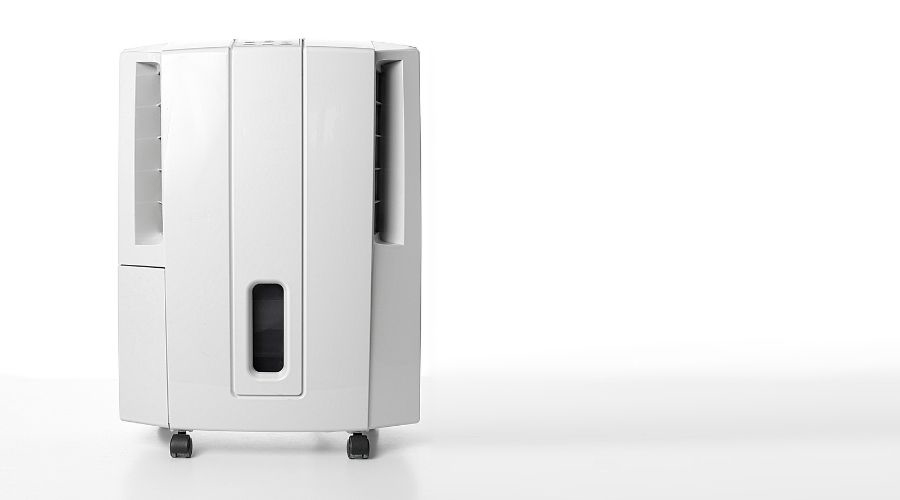
When you invest in anything, you make the conscious decision to maintain it to the best of your ability in most cases. You will endeavor to pick up any information you can along the way to make your newly acquired item last long enough to get your money’s worth.
However, one might ask how long your dehumidifier lasts and what kind of tricks you can do to increase its lifespan.
A dehumidifier can last between 5 to 10 years, depending on its usage and giving the unit a little TLC. Taking care of the dehumidifier includes:
- Changing the filter periodically.
- Emptying and cleaning the water bucket.
- Cleaning the exhaust grilles and condensing coils.
Keeping your dehumidifier running well can be a tiring effort, to be sure. Still, with a few quick trips, you can almost guarantee your unit’s life expectancy is above average by doing the abovementioned things. Let us read more information down below.
How Long Do Portable Dehumidifiers Last?
Before we delve into how to keep your dehumidifier up and run for the longest time possible, just how long are they supposed to last you in the first place?
This question can vary from brand to brand, and as we said above, it can change dramatically depending on how you care for it. Still, you can expect a dehumidifier to last for roughly 5 to 10 years before something inevitably wears out on it.
If we work with that understanding, we have to conclude that certain parts or aspects of your unit are more likely to break down than others. However, which parts would these be, and what contributes to these instances?
The answer here quite simply is overuse. When constantly running your dehumidifier, you are putting constant strain on all the components inside. Much like yourself, if your unit doesn’t have ample time to rest, it will wear out much faster than you’d think.
People who use a dehumidifier year-round will expect their unit to last considerably shorter than another individual who only uses theirs during certain seasons.
It is essential to sustain your dehumidifier’s lifespan by ensuring it is routinely cleaned and in a location that won’t allow it to freeze up.
If it is constantly frozen, it can damage it and shorten the lifespan or have unexpected incidents, such as being knocked over.
These seemingly ordinary precautions can greatly benefit your dehumidifier’s overhaul longevity. They can make your entire life easier by association.
It is especially true if you need to consider buying multiple dehumidifiers due to your location or the extent to which you plan to utilize them.
Now that we know the basics understanding different kinds of dehumidifiers allows us to get a better glimpse of what we can do to keep them running safely for longer.
Types of Dehumidifiers
In the grand scheme, two different kinds of dehumidifiers are primarily refrigerant and desiccant. The difference between the two being one is, by and large, an electrical appliance that uses special coils to remove water from the air.
In contrast, the desiccant uses unique humidity-absorbing material to achieve the same end goal.
1. Refrigerant Dehumidifier
A refrigerant dehumidifier is an electric-based type that utilizes evaporator coils to draw moist air and heat them over a condenser coil.
The condenser removes excess water and releases it back through one of the many vents in the machine, reducing humidity in the process.
Between the two, this is easier to maintain but has some callbacks on it as well. It is an electric appliance and will consume energy to work.
The benefit from this is that you can experience the benefits from the unit much faster than the Desiccant in most cases.
2. Desiccant Dehumidifier
On the other hand, the desiccant directly absorbs moisture from the air and must be “recharged” to repeat the process. In this case, recharging means heating the material to dry enough to absorb more moisture from the air.
Desiccant dehumidifiers can also function in temperatures much lower than their electric counterparts. Operating more in colder weather does not have internal components that can freeze up and damage the dehumidifier.
One final difference between the two would be that, seeing as the desiccant has no moving parts, it is typically the more silently functioning of the two.
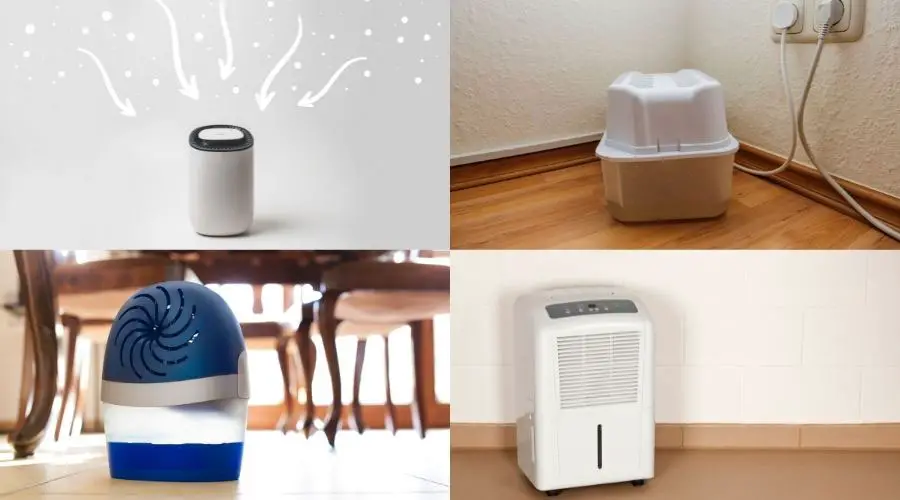
Classifications of Dehumidifiers Based on Size
Viewing dehumidifiers as a whole, you have three primary scaled sizes to look at, and the functionality of each varies significantly on that same size reference.
These sizes break down into three primary classifications: portable, mini, and whole-house. Each serves a purpose the others couldn’t handle or potentially handle too well.
1. Whole House Dehumidifier
The whole house dehumidifier would handle the entirety of your home with relative ease. Assuming you placed it in a suitable spot, the air current could eventually reach your entire house sufficiently.
2. Portable Dehumidifier
This kind of dehumidifier specializes in simply being able to be maneuvered around your home or wherever you place it with relative ease.
Its mobility could be because it is relatively light, has wheels, or any other rationalizations. Still, the most important takeaway is that you can move it without requiring immense effort for the endeavor.
3. Mini Dehumidifier
A tiny kind of dehumidifier that you can take anywhere you please is typically lightweight and specialized in being placed in smaller, enclosed environments.
These dehumidifiers are perfect for removing excess moisture from things like safes and gun holders. You might want to store items or clear water anywhere else but not want an entire unit to cram inside.
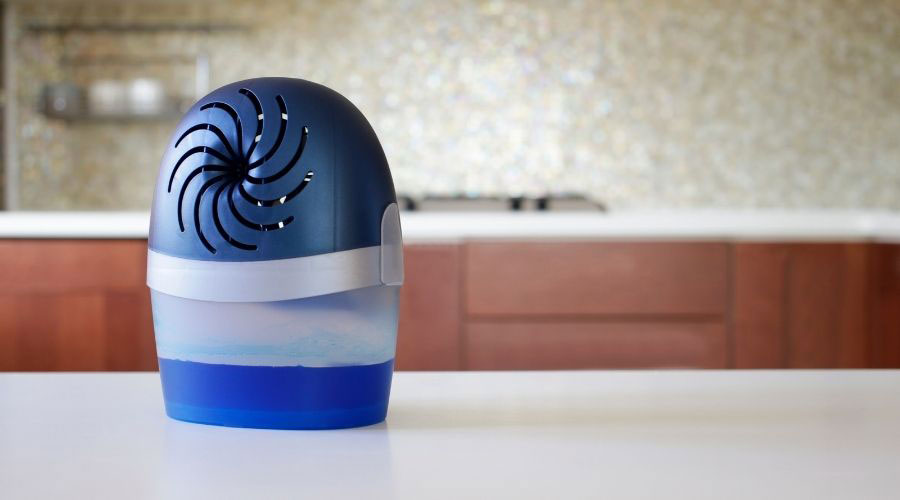
Tips for Maintaining Your Dehumidifier
Moving along, let’s check in on what quick and easy tips you can use to keep your dehumidifier working for as long as possible.
In most settings, a dehumidifier can be considered an easy-care device. Usually, you’ll only need filters to be cleaned every so often and keep chunky dust and debris out of it. However, you can do some particular things to keep it going the extra mile!
It might be wise to make a small chart. The chart would utilize the following:
- What would fit your lifestyle
- What would make it less of a pain
- Divide the labor up amongst other people in the household
You would not want the burden on you to take care of your dehumidifier! Doing so will take the chore side out of the upkeep and give you a better chance of keeping your unit functioning longer.
1. Adjust the Humidistat
While appearing of seemingly no consequence initially, changing your humidistat to the correct level depending on the weather around you greatly impacts your unit’s overall longevity.
Doing this is not necessarily a small part due to the effort required to chase this humidity level.
Suppose the humidistat is attempting to reach a level that isn’t attainable or difficult to reach given current temperatures. In that case, it may cause the machine to freeze up in colder weather.
The frozen machine can damage several internal components, or it may constantly run in pursuit of that unattainable level and damage your unit.
In the warmer seasons throughout the year, you would want to have your humidistat set at roughly 30-50 percent.
However, as the year draws on and the colder months come in, you would want to set the humidistat to 30-40 percent, especially when ambient heating comes into play.
2. Replace or Wash the Filter
Cleanliness is next to godliness, as the saying goes. It is especially true for our moisture-removing friend, the dehumidifier.
The filter is the only line of defense against excess dust, allergens, and any other airborne contaminant that can float into your dehumidifier. If left unchecked, it could cause irreparable damage to specific pieces in the machine itself.
Aside from keeping your dehumidifier running smoothly, the filter serves a greater purpose of keeping the air warm and moist-free.
It generates clean and free of the same disgusting things it removes in the process. In that case, you could also consider your dehumidifier a makeshift air purifier!
It’s worth noting that the process and methods required to clean or replace your filter vary greatly depending on your model. As such, it would be wise to consult your manufacturer’s guide to ensure you remove the filter safely without damaging the unit.
3. Ensure Your Dehumidifier is in the Right Spot
Taking time to find the perfect place for your dehumidifier has a myriad of benefits that come into play. These extend far past you, not tripping over it at night on your way to the bathroom!
Say you have one dehumidifier, and it is in a centralized location in your home. In that case, it allows the unit to function far more efficiently than if it were in the corner of the house, attempting to draw all the air to that location and cycle it out again.
A better location would mean your dehumidifier doesn’t have to work hard to achieve the same goal. It will be allowed to turn off once the correct humidity level is reached, thoroughly extending the device’s longevity.
4. Look for Frost Buildup in the Condenser Coils
Assuming you are operating your unit in colder temperatures, you could experience a bit of a freeze-up. This instance is arguably one of the worst things that can happen to the dehumidifier itself.
The condenser coils freezing up can cause leaks, breaks, or even significant scale malfunctions, ultimately breaking your dehumidifier entirely.
Making sure you give the coils a quick inspection can save you a healthy amount of money in repair fees and keep your unit running by association.
Combating this specifically in those colder months is a fight you must do according to your manufacturer’s code. Refer to the manual to know how to deal with it properly with your dehumidifier’s model.
5. Clean the Device Regularly
Cleaning your filters and such will do wonders. Still, you could take a little initiative and thoroughly clean the entire dehumidifier while you are at it.
Giving your dehumidifier a good cleaning alleviates your machine’s added pressure and makes its primary functions easier to perform.
Not all dehumidifiers can be easily accessed to clean them, which is entirely understandable. Still, giving the areas you have access to a sweep of your vacuum hose to get extra dust build-up will do wonders for your device.
Opening it up if you are under warranty on your dehumidifier may void the contract itself. In that case, going past the small area where your filter is located may not be worth the risk.
This is especially true if you don’t know how to put your dehumidifier back together after tinkering around.
Disassembling or working inside the dehumidifier should always be done with the device securely while being unplugged. Having the device unplugged avoids potentially getting shocked or, worse, electrocuted.
6. Avoid Short Cycling the Compressor
The final tip for keeping your dehumidifier up and running would be giving it ample time to rest during off and on cycles so that you don’t short cycle it.
Short cycling means you are placing extreme stress on the unit by not giving it time for the excess pressures inside it to equalize. Some units have built-in delayed start functions to reduce this from happening, but unless you know for sure, don’t risk it!

How Long Should a Dehumidifier Run Each Day?
The answer to this question lies in how large the space you are attempting to run your dehumidifier in. It will also depend on whether or not your unit can handle the job at hand.
The Right Size Unit
Suppose you took the time to research and purchased a dehumidifier that can sufficiently stabilize the humidity in your home or the area given. In that case, you could expect things to normalize within a day to a week, depending on the humidity levels.
Small Units in Larger Areas
Alternatively, assume you purchased a smaller unit and have a bigger house or area. In that case, the dehumidifier will struggle to accomplish the job and take a long time to achieve the goal. In severe cases, it will never happen and destroy itself relatively quickly for the effort.
For these same reasons, you should always invest a little extra time before purchasing your unit to guarantee you get the right-sized unit for the right job.
Remember, you want your unit 8 inches from a wall. Being more in the center will guarantee the vents, fans, or exhaust points are not hindered. These things may increase the amount of effort to stabilize the humidity in the room.
Can You Repair a Dehumidifier if it is Faulty?
In most cases, there is something that you can do to repair your dehumidifier. If something goes wrong with it, the timing of the unit malfunctioning can make all the difference in the world.
Suppose your dehumidifier was faulty out of the box. In that case, you should be able to return to the store. If you purchased your unit online, immediately send it back for a refund or another device. Another scenario is if something goes wrong on it under warranty, you do the same procedure for the fix.
However, if none of the above apply to you, and you are out of warranty and didn’t purchase the unit, you can take it to a maintenance specialist to get it fixed.
Yet, odds are, repair costs may not be worth it, considering your more extensive repairs would cost the same as simply replacing the dehumidifier entirely.
How to Tell if Your Dehumidifier Stopped Working
Almost all dehumidifiers can offer some visual indicator that it is at the very least on.
These indicators may be a green light, visual tracking of the desired humidity levels, or even ambient noise from the unit itself. There are several ways of knowing if it is indeed working.
However, knowing something is wrong can be a different beast entirely. In that case, you may want to look towards the opposite of the above statements, which are reasons indicating it does not work:
- Lights being off
- Lack of reading
- No noise at all
- Increased humidity levels
If you are looking for more specific issues, check if the internal fans are running by listening closely to the unit.
You may also notice a lack of water build-up in the storage tank could be more easily diagnosable signs of some problem brewing within the device.
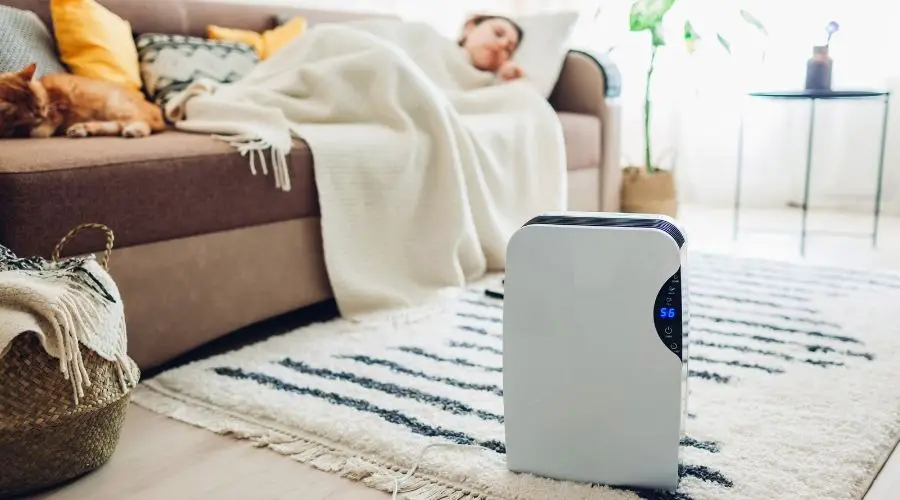
Is it Worth Fixing a Dehumidifier?
As with all repairs, it depends entirely on the issue and the lengths you would need to go to replace the malfunctioning piece to get things back in working order.
Suppose the fix is relatively simple, like a filter broke, and you need to buy a new one. In that case, that is ordinary enough to be considered a maintenance fix.
More significant issues can lend credibility to a larger problem that could be so expensive to fix would be more worthwhile to replace it entirely. These issues may be:
- The unit fails to turn on
- Being overly noisy, considering it was almost silent when you initially purchased it
- The dehumidifier fails to collect water at all
Ultimately this boils down to the cost and time required to fix the issue. If the repair cost exceeds the unit’s value, get rid of it and save yourself time and money.
Alternatively, suppose the fix is something you feel safe doing as a DIY project, and you can do it in a small amount of time. In that case, it’s well worth salvaging the unit itself.
Conclusion
The longevity of your dehumidifier increases if you take the time to do the following;
- Diligently take care of it
- Removing excess dirt and grime
- Ensure that it doesn’t have to overwork itself
- Giving it ample downtime to not wear out the parts that make it function.
A tiny bit of effort in your unit’s routine maintenance will guarantee you get your money’s worth. In today’s age, saving money anywhere you can is a feat worth pursuing if you can do so.
Hopefully, this article gave you the knowledge to extend the lifetime of your dehumidifier and help you determine which size you might need to fill your needs perfectly!


